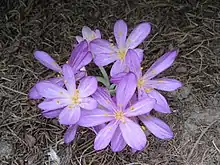Colchicum cilicicum
Colchicum cilicicum, the Tenore autumn crocus, is a species of flowering plant in the Colchicaceae family.[2] A bulbous perennial, it bears deep rose-lilac flowers in late summer, with barely any chequered pattern on the petals (tessellation).[3] It has a very noticeable white stripe down the centre of each petal, which gives it a star-like appearance at the base. The flowers tend to stand up to weather better than other colchicum blooms. The flowers appear before the strap-like leaves, giving this and other colchicum species the common name “naked lady”. Although colchicums are called “autumn crocuses” they belong to a different family than true crocuses. There are in fact autumn-flowering species of crocus such as Crocus sativus, which is the source of the spice saffron. Colchicum cilicicum, by contrast, is toxic if eaten.
| Colchicum cilicicum | |
|---|---|
 | |
| Scientific classification | |
| Kingdom: | Plantae |
| Clade: | Tracheophytes |
| Clade: | Angiosperms |
| Clade: | Monocots |
| Order: | Liliales |
| Family: | Colchicaceae |
| Genus: | Colchicum |
| Species: | C. cilicicum |
| Binomial name | |
| Colchicum cilicicum | |
| Synonyms[1] | |
| |
This species is native to Turkey and Syria.[1][4]
It is found in cultivation, and under its synonym C. tenorei has gained the Royal Horticultural Society’s Award of Garden Merit.[5] (confirmed 2017).[6] The cultivar 'Purpureum' is also a recipient of the award.[7]
References
- "Plants of the World Online | Kew Science". Plants of the World Online. Retrieved 2023-08-04.
- "Colchicum cilicicum (Boiss.) Dammer". Plants of the World Online. The Trustees of the Royal Botanic Gardens, Kew. n.d. Retrieved September 16, 2020.
- Carl Lebrecht Udo Dammer. 1898. Gardeners' Chronicle. London ser. 3, xxiii. 34, Colchicum cilicicum
- Autumn Bulbs by Roy Leeds (B.T. Batsford Ltd) 2006 ISBN 0-7134-8962-6
- "RHS Plantfinder - Colchicum tenorei". Retrieved 12 January 2018.
- "AGM Plants - Ornamental" (PDF). Royal Horticultural Society. July 2017. p. 22. Retrieved 24 January 2018.
- "Colchicum cilicicum 'Purpureum'". RHS. Retrieved 12 April 2020.